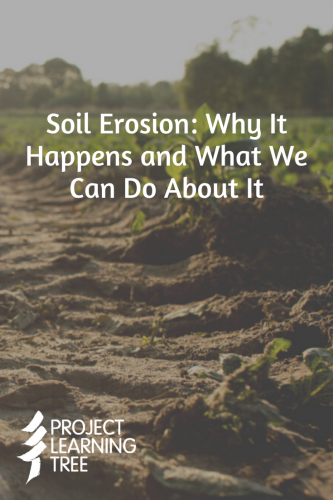 Soil, or all the “dirt” between the plants and living matter and the bedrock at the bottom, is unbelievably important for forests and all of life on earth.
Soil, or all the “dirt” between the plants and living matter and the bedrock at the bottom, is unbelievably important for forests and all of life on earth.
The amount of soil in any given place is constantly changing. Soil builds up from decay and the breakdown of dead plants and animals, and eroding rocks. When rain falls, water runs through the soil and erodes and washes it away. This is an important element of understanding soil health: soil can erode, but it can also be built back up through actions like collecting compost, mulching leaves and grass instead of bagging them, etc. You might think the ground under your feet is solid, but it’s ever-changing.
Soil erosion, or the loss of all that important stuff, is a natural phenomenon caused by water and wind but can become more of a problem as humans inhabit and develop more of the planet. If unchecked, erosion can strip away valuable soil and negatively affect the water we consume, our ability to grow food, and the plants, animals, and land around us, all of which depend on soil.
Fortunately, there are many ways to encourage soil development and prevent and mitigate the effects of soil erosion, and the subject is one your students will find highly engaging and applicable.
Why We Should Be Concerned About Soil Erosion
Topsoil is the uppermost layer of soil from which you see plants sprout. Topsoil is critical for 95% of humankind’s food supply and many interdependent plants and animals that rely on it.
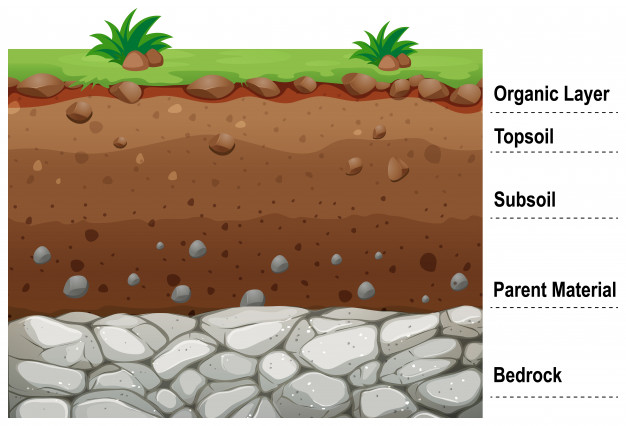
On much of the world’s most productive agricultural land, almost half of the rich topsoil has disappeared in the last 150 years. Human activities, such as poor farming practices like overgrazing and improper tilling contribute to soil erosion. Climate change also exacerbates soil erosion due to more intense rainfalls and droughts.
When soil erosion happens on a large scale, it can also create human-made deserts by forcing out topsoil and leaving behind sandy particles that don’t retain moisture or nutrients well. Sandy soil is more likely to wash away, get carried off in the wind, and become a desert in times of drought.
Soils also protect waterways from potentially harmful agricultural chemicals, preventing runoff from harming fish or polluting drinking water sources. Soils that are stripped away of plant vegetation next to waterways can erode, causing sedimentation build-up that may be harmful to fish spawning beds, and can cause costly and dangerous road blockages and potential flooding.
Exercise – Geology, Science: This e-booklet from the Food and Agriculture Organization of the United Nations includes fun activities and lab experiments for middle and high school students that delves into the topics of soil and erosion.
Also consider giving your students a deeper understanding of the soil beneath their feet with these great resources for grades K-12 from the Soil Science Society of America.
Younger students will enjoy our hands-on Soil Stories family activity (available for download in either English or Español) by placing soil into a jar with a lid and adding two cups of water. Ask them to predict what will happen if they shake the closed jar and let it settle for a few hours. Then, try it.
Have children draw a picture of the layers formed by their soil shake, or collect and test soil samples from other areas (forest, field, yard) for comparison. Next, challenge children to complete the “Soil Composition” diagram, reminding them that the largest particles fall to the bottom first.
Soil Erosion Caused by Water
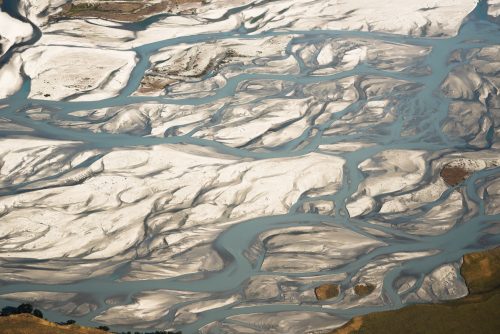 There are four types of soil erosion caused by water [2]:
There are four types of soil erosion caused by water [2]:
- Rill erosion. Water flows over the ground and lifts soil along with it, creating small channels, or rills, that pick up more soil before they deposit sediment in streams and reservoirs.
- Gully erosion. Water moves with such force that smaller channels can widen into gullies and cause water to erode even deeper layers of soil.
- Sheet erosion happens when water flows downwards and detaches an entire layer of soil.
- Bank erosions: This type of erosion happens as water in drainage channel banks cause progressive undercutting, scouring, and slumping, as channel banks fall into the waterway and are washed away.
Water erosion also happens along streams or riverbanks when the water flows so powerfully that it picks up chunks of soil along its way. This can alter the surrounding landscape and even the course of a river.
Factors that affect the rate of water erosion:
- Rainfall intensity. When it rains, water droplets dislodge finer components of soil like sand, silt, and clay. Rainfall that comes down harder or longer is more likely to carry off larger particles of soil like sand and gravel.
- Soil condition. Soil’s makeup determines its ability to absorb water. Generally, soil that absorbs water faster and consists of more organic matter or more advanced soil structure has the best resistance to erosion. Soil with richer nutrients is home to fungi, bacteria, rodents, insects, worms, and other organisms that help make it more erosion-resistant.
- Slopes. Surface water runoff occurs whenever there’s a slope and excess water can’t be absorbed into the soil. The steeper or longer the slope, the faster water travels and the more sediment it gathers along its way. It’s increased by soil compaction, including when it’s frozen.
- Vegetation. Plants can intercept falling rain before it hits the soil, slow water runoff, and their roots bind the soil’s components.
Soil Erosion Caused by Wind
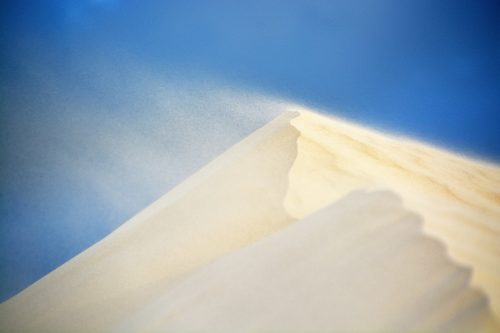 Wind has its own powerful way of transporting soil. It’s even carried sands from the Sahara Desert in Africa all the way to the Southeastern United States.
Wind has its own powerful way of transporting soil. It’s even carried sands from the Sahara Desert in Africa all the way to the Southeastern United States.
Wind affects a smaller percentage of land (mainly loose, dry, and bare soil found in arid conditions) by picking up particles of soil in three ways:
- Suspension: Tiny particles float high in the air where they can linger for days.
If wind scatters seeds or covers seeds and plants in layers of sand, crops can become ruined. When smaller particles blow away from the ground, the soil surface deflates to become lower and rockier. Soil nutrients, along with fertilizer or potentially harmful surface chemicals, can also be carried away with soil or dust and negatively impact elsewhere.
- Saltation: Larger particles, like sand, stay close to the ground as the wind moves them in short bursts.
When wind drops larger particles onto land, it can damage vegetation and dislodge soil and even seeds. Rocks can roll away, and a topsoil layer can become damaged by partially blowing away or become covered when the wind blows other particles on top of it.
- Creep: Wind pushes particles larger than sand along the ground.
Wind works as an abrasive and can blow and scrape sediment like sand against rocks and other surfaces, forming interesting shapes. This can also damage young plants.
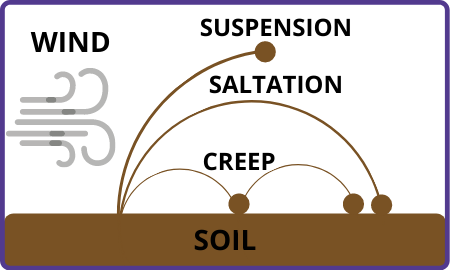
Factors that affect the rate of wind erosion:
- Wind speed and duration. The higher the wind speed and the longer the wind blows, the more force it has to carry away soil.
- Soil condition. The drier or looser the soil, the greater its risk of blowing away.
- Vegetation. Plant roots hold soil together and foliage provides added wind protection.
Poor Tillage Practices
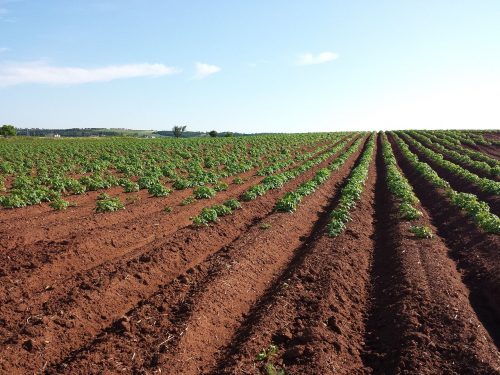
Tillage erosion can actually do more erosion damage than water or wind alone because some farmers frequently remove such great amounts of soil.
As soil is continually tilled, nutrients may be exposed to the air and lost. Improper tilling can also disturb organic and plant life that strengthens the soil, leaving it more erosion-prone.
When farmers till their crops up and down slopes, this also creates easy pathways for water runoff and heightens the risk of water erosion.
Exercise – Geology, Research, Critical Thinking:
What major landscapes were formed by wind and/or water erosion? Compile a list of a few notable examples with your class. Then, ask your students how they believe each landscape was formed.
Consider having older students look up these answers themselves or write a research paper on how the landscape of their choice was shaped by water and/or wind erosion. With younger students, look up the answers as a class.
How to Prevent Soil Erosion
Here are key ways to prevent soil erosion to share with your learners:
Revegetate Critical Areas
Land is much stronger when plants add roots, nutrients, and coverage to protect it from rainfall and wind.
If revegetating, consider choosing trees, shrubs, grasses, or other plants that are native to your area, that develop extensive roots, and cover the ground for the longest amount of time in a year.
Laying plant matter like mulch on a landscape can also ease the ground’s ability to absorb water and improve erosion resistance.
Exercise – Geology, Science, Critical Thinking:
What kind of vegetation might be suitable to help control erosion in your community? What are methods that can help encourage the growth of new vegetation, especially along slopes? Have you seen any of these methods used in your community or where you’ve traveled? If you have ever seen a sign advising you to stick to a trail, what did you think at the time compared to what you think about it now?
Support Organizations That Minimize Erosion
It’s far easier to prevent soil erosion from happening rather than repair its damaging effects later.
Exercise – Civics, Science, Critical Thinking:
Are there any organizations you might support in your community, country, or nationwide that work to prevent or fix damage caused by erosion or deforestation? Do you know of any organizations working to vegetate critical areas?
Are there any companies you could contact to ask them to take steps to lessen their contribution to soil erosion?
For inspiration, discover how these young environmentalists advocated for environmental improvements. One second-grader even changed the way McDonald’s sources their paper products to minimize deforestation in his state!
Support Sustainable Agriculture
Sustainable agriculture works in greater harmony with the environment. Generally, it values:
- Recycling resources as much as possible. This includes converting waste into fertilizer to increase the nutrients in the soil for crops.
- Using minimal resources beyond what nature already provides (sun, soil, water, and biodiversity).
- Raising a diversity of crops and animals on the same farm. Their interactions benefit each other.
- Practicing resilience methods like contour farming to minimize erosive damage. Contour farming involves tilling along row patterns wrapped horizontally along a hill’s contours instead of up and down.
Exercise – Agriculture, Science, Critical Thinking:
Check out this great resource from the Johns Hopkins Center for a Livable Future: Foodspan for lesson plans for high schoolers that cover important sustainable agriculture topics. Lesson 6 is a particularly great resource and that can be adapted for younger learners. Discover what it looks like when farming nourishes natural ecosystems.
Support sustainable farming by incorporating a few simple steps as you see fit:
- Eat local and organic.
- Contact farmers, agricultural organizations, or university agricultural programs to ask how they’re incorporating techniques like proper tillage, zero net deforestation, sustainable pasturing practices, and what they’re doing to prevent climate change, pollution, and erosion. You can simply listen to increase awareness or take it a step further and advocate that they incorporate more sustainable farming practices to minimize these issues.
- Contact local legislators to advocate for sustainable agriculture.
- Limit your consumption of meat and animal products.
Envision and Build Structures that Control Erosion
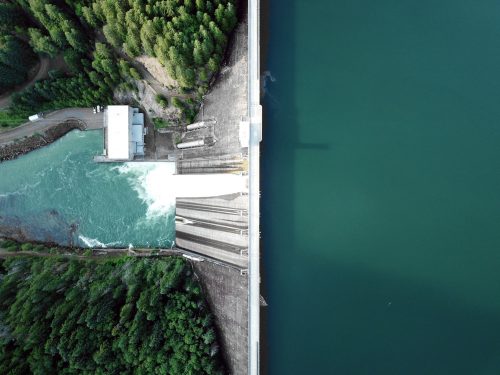 When designing a project like a road, it’s important that engineers carefully consider environmental factors like slope length, steepness, and underlying and surrounding soil types when creating ways to properly drain or contain excess runoff.
When designing a project like a road, it’s important that engineers carefully consider environmental factors like slope length, steepness, and underlying and surrounding soil types when creating ways to properly drain or contain excess runoff.
Continued maintenance of these structures is critical. Something so small as a crack in a concrete drain can cause water to rush through it and cause a landslide.
Some notable water containment or drainage structures include:
- Sediment basins
- Reservoirs
- Dams
- Levees
- Ditches (Can include rocks for better water flow)
- Silt fences.
- Specialized ditches (Like a J ditch or drainage interceptor ditch)
- Gutters
- Drains (Can be optimized to prevent clogging)
Exercises – Science, engineering:
Next time you see a parking lot, try predicting where water will drain during the next storm, or will it just pool?
What are some other notable examples of human-made methods that minimize the impact of soil erosion in communities or farming? Are there any examples in your own community? Can any of these methods be combined for more efficient erosion control? Can you think of a new method?
Let students investigate for themselves which erosion control methods are most effective in this energizing lesson.
Fight Climate Change Through Education and Action
Rising temperatures contribute to soil erosion in the form of increased weather events: from more frequent and intense hurricanes to less snow and more rain, too much water can increase sediment erosion. Combating climate change can also help prevent soil erosion.
Exercises – Art, language arts, music, technology, civics, etc.:
Education:
- PLT’s Carbon & Climate E-Unit provides activities and resources to help educators introduce students to some of the complex issues involved in climate change. You can also download a free worksheet from the e-unit.
- Teaching About Climate Change: Water, Trees, and Wildlife is a reference guide for activities from Project Wet, Project Learning Tree, and Project Wild that can help you explore the topic of climate change with your students.
- The National Association of Conservation Districts’ 2019 Poster Contest and Stewardship Week theme was “Life in the Soil: Dig Deeper.” Check out their webpage containing free activity worksheets for Grades K-8, coloring pages, and additional teaching resources.
Encourage your students to take action for soil health with these resources:
- Climate Kids: What Can We Do to Help?, from NASA, is designated for students in grades K-8. Games, activities, animations, and the latest news on climate change are featured in a kid-friendly format.
- Get involved with reuse, reduce, and recycle efforts that help alleviate climate change. Check out this blog for more resources and relevant activities in every subject area.
- Incorporate students’ top passion with a way to advance climate justice and journal to discover how they might want to help. Could they film a video that increases awareness of how healthy soil can mitigate climate change? Are they a leader who can create a club working to create change in their school and community? What about creating recycled art projects to draw attention to some important environmental issues?
[1] Layers of Soil Graphic (education vector created by brgfx – www.freepik.com)
[2] OMAFRA Factsheet: Soil Erosion – Cause and Effect. Order No. 12-053 (link here)


